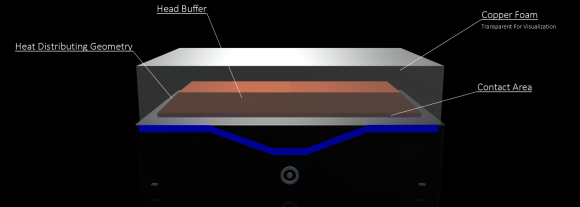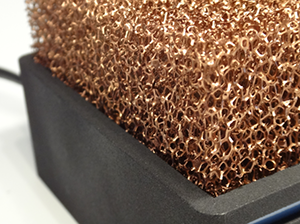Hold on to your hats, because this is a good one. It’s a tale of disregarding the laws of physics, cancelled crowdfunding campaigns, and a menagerie of blogs who take press releases at face value.
Meet Silent Power (Google translation). It’s a remarkably small and fairly powerful miniature gaming computer being put together by a team in Germany. The specs are pretty good for a completely custom computer: an i7 4785T, GTX 760, 8GB of RAM and a 500GB SSD. Not a terrible machine for something that will eventually sell for about $930 USD, but what really puts this project in the limelight is the innovative cooling system and small size. The entire machine is only 16x10x7 cm, accented with a very interesting “copper foam” heat sink on top. Sounds pretty cool, huh? It does, until you start to think about the implementation a bit. Then it’s a descent into madness and a dark pit of despair.
There are a lot of things that are completely wrong with this project, and in true Hackaday fashion, we’re going to tear this one apart, figuring out why this project will never exist.
The Hardware
The specs for this machine are pretty good; it’s not a slouch by any means. The CPU is an Intel i7 4785T. A pretty good chip, but one with the lowest thermal design power of its generation – 35 Watts – not surprising given that the team behind Silent Power is going for a completely passively cooled product.
The graphics card, however, is not a low power part. The Nvidia GTX 760 is a 170 Watt card, and most certainly not the best choice for a passively cooled system. A better choice would be the GTX 750 Ti: they would get reasonably similar performance with a 60 Watt card. saving them from having to get rid of 110 Watts of heat. If you’ve ever touched a hot 100 Watt light bulb, that’s about how much heat the small performance increase from the GTX 760 to the GTX 750 Ti produces. That’s also the amount of extra heat the innovative copper foam heat sink needs to get rid of because of this one design decision.
Chip choices and component selection notwithstanding, a much more interesting aspect of this hardware is the form factor. It’s a pretty small enclosure, only 16x10x7 cm. The smallest commonly available motherboard size, Mini-ITX is 17 cm square and obviously wouldn’t fit in the enclosure. Maybe they’re going with a newer, smaller form factor like the Intel NUC? Nope. They’re designing their own integrated system, mounting the GPU and CPU on one board, and the RAM and the Flash chips that make up the SSD on another. There are supposedly a total of three boards in this computer, all separated by expensive, high-speed interconnects.

Just about every graphics card and motherboard you can buy isn’t designed from scratch. Instead, chip companies like Intel, AMD, and Nvidia produce what are called reference designs, which are produced by companies like Asus, Gigabyte, MSI, and EVGA. Yes, there are a few differences in peripheral support, thermal design, and layout, but the basic fact that there are only a handful of designs out there for a specific class of GPU or CPU holds true.
The team at Silent Power is creating a completely new design for their specific choice of CPU and GPU. That’s a tremendous undertaking and something that costs chip manufacturers millions of dollars to produce. The Silent Power team is willing to do all of this for $60,000 USD with a team of three.
Copper Foam
With the hardware design thoroughly debunked, we can move on to the most interesting feature of the Silent Power PC: the heatsink. It’s made of a material called copper foam, an open cell matrix of copper. At first glance, this looks like a decent choice for a heat sink. Copper is extremely thermally conductive, and the huge amount of surface area means there’s a lot of area for heat to radiate out of.
The reality is that this copper foam is a more effective insulator than a conductor of heat.
Heat sink design is no simple matter, and simply by observation of stock heatsinks, a few generalities can be observed. Most heat sinks are made from aluminum, and while the most common explanation for this is the price of copper versus the price of aluminum, that’s not the whole picture. All heat sinks have a property called emissivity, or the effectiveness of a material in emitting thermal radiation. When it comes to the emissivity of heat sinks and radiators, color is important. The radiator in your car is painted black, and the heatsink on your CPU is most likely black anodized aluminum. Copper cannot be anodized and short of artificially oxidizing their copper foam, the Silent Power team can do nothing to improve the efficiency of their chosen material.
Another consideration in the design of heat sinks is the area of the fins. The fins on every heat sink have something called a ‘boundary layer,’ or an area where heat is transferred from the metal to the air. A lot of time and resources have been dedicated towards calculating the ideal size, shape, and spacing of fins in a heat sink to optimize heat transfer with this boundary layer in mind. A copper foam is not an ideal heat sink. The boundary layer for all the cells in the foam quickly reaches capacity; after that, radiating any more heat is impossible.
This is, quite literally, one of the worst possible heat sinks imaginable.
Previously Found On Indiegogo
While being a crowdfunded project, Silent Power can’t be found on any of the regular sites like Kickstarter or Indiegogo. They’re doing the crowdfunding by themselves, asking everyone to contribute towards production via Paypal. The plan is simple: send some money to them via PayPal, and when they receive €45,000, they’ll start production. If they don’t receive the funds necessary, they’ll refund all of the potential buyers, minus PayPal fees.
Read that last paragraph again and tell me if that’s a reasonable deal. There are things called, ‘investors’ and ‘loans’ that might also work in this situation, doubly so if you’re running a business.
It’s certainly an unorthodox way of raising money for a project, and with a little bit of googling, you quickly find the reason why. Here’s the link to their previous Indiegogo campaign. That campaign was pulled down by the Indiegogo, “‘without warning and justification,” according to the team. If anyone can find a cache of that campaign somewhere, I’ll gladly link to it.
Yesterday, the Silent Power team hit a bit of a snag. Paypal froze their account. Yes, this means all the funds to be used in the development of this project are now locked away, and yes, this means the team has no funds to develop the project further.
That doesn’t mean the Silent Power team is calling it quits just yet: they’re still accepting payments and pre-orders to a frozen Paypal account, ready to start production when their account is unfrozen. The mind reels.
Wrap Up
This is only a cursory assessment of this project, and far from a complete look at the failings of the Silent Power PC. There’s much, much more to talk about here but really only one word that can describe the totality of this project: insane.
I would like to take a few words to point out that this is a critical assessment that comments on the engineering and design of the Silent Power PC, something the rest of the tech blogosphere didn’t seem to manage. In no particular order, here is a list of blogs that have taken an uncritical look at the Silent Power PC, without taking the effort to determine if it is real or not:
- The Verge
- Gizmodo
- Gizmag
- PC World, with the quote, “That’s not to say Silent Power isn’t legit—far from it…”
- Techspot
- Ubergizmo
- Stuff.tv
There is really nothing more for me to say, but there are still dozens of reasons why this project will never see the light of day. Comments welcome below.

















You lost my when you stated that a 750 Ti is close in performance to the 760. They’re worlds apart in performance.
This ‘Copper foam’ must be tested in combination with benzoylmethylecgonine and applied heat. I require a sample for testing purposes.
After reading your article about the lithium ion supercap batteries (http://hackaday.com/2014/07/17/a-lithium-ion-supercapacitor-battery/) your reputation for a technical analysis is on a all-time low. And this article isn’t better at all, just longer.
BTW: doing a CPU/GPU layout with 3 people shouldn’t be too hard. As you’ve written there’s a lot of documentation how to do it available. Just doing it for 60k$ seems a bit odd, esp. as there’s much more work to do than the layout…
http://www.reddit.com/r/shittykickstarters
This heatsink would probably only work well with forced convection of superfluid liquid helium, due to the laminar flow dominating turbulent flow and the large head loss caused by the immense surface area to volume ratio of the sponge. I don’t believe the color has anything to do with the thermal emissivity for radiant cooling, but this required an experiment to be conducted (unless someone has already done one), i.e. using identical dummy loads with different colored heatsinks, but the same thermal conductivity, such different colors of spraypaint, and measuring the input energy and temperature.
Ooh! But it looks so pretty!
I own the following:
– GTX 650ti
– GTX 760 4GB ED
– I returned a GTX 960
– I returned a GTX 970
– I gave Nvidia the finger and bought an AMD R9 390 now I understand how Linus Torvalds felt.
– I have an AMD FX 8 core, 32gb ram, 4tb hddr, 800/psu, in a cube case.
What sucks:
– GTX 650ti not good but not bad more a budget card. It’s like a cheap razor blade.
– GTX 760 bottlenecks on 4gb edition it uses only 2gb. <– This card is shit do not get it.
– GTX 960 felt like what the 760 and 770 should have been. On itself the card was shit, the power to handle mid graphics is just not there.
– GTX 970 yup another bottleneck edition. <– This card is shit do not get it.
– There must be a pattern ala Microsoft here?!
What I like about the R9:
– Directx 12
– OpenGL 4.5
– Mantle or Vulkan for you Nvidiots.
– 8GB…. YES 8 fucking working gigs, no bottlenecks!!
– Did I mention a cube case?!